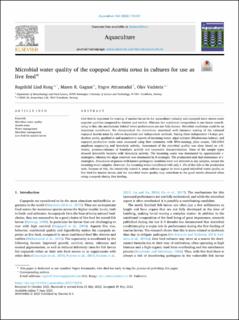| dc.contributor.author | Rong, Ragnhild Lind | |
| dc.contributor.author | Gagnat, Maren R | |
| dc.contributor.author | Attramadal, Yngve | |
| dc.contributor.author | Vadstein, Olav | |
| dc.date.accessioned | 2022-12-05T08:37:28Z | |
| dc.date.available | 2022-12-05T08:37:28Z | |
| dc.date.created | 2022-10-21T13:49:41Z | |
| dc.date.issued | 2022 | |
| dc.identifier.issn | 0044-8486 | |
| dc.identifier.uri | https://hdl.handle.net/11250/3035766 | |
| dc.description.abstract | Live feed is important for rearing of marine larvae in the aquaculture industry and copepods have shown some superior qualities compared to Artemia and rotifers. Whereas the nutritional composition is one factor contributing to this, the mechanisms behind better performance are not fully known. Microbial conditions could be an important contributor. We characterized the microbiota associated with intensive rearing of the calanoid copepod Acartia tonsa by culture-dependent and independent methods. During three independent 14-days production cycles, qualitative and quantitative aspects of incoming water, algal cultures (Rhodomonas baltica), and copepod production tanks were measured using flow cytometry with RNA-staining, plate counts, 16S-rDNA amplicon sequencing and hemolytic activity. Assessment of the microbial quality was done based on r/K-theory, presence/absence of hemolytic activity and taxonomic characterization. None of the sample types showed detectable bacteria with hemolytic activity. The incoming water was dominated by opportunistic r-strategists, whereas the algae reservoir was dominated by K-strategist. The production tank had dominance of r-strategists. Abundance of genera with known pathogenic members were not detected in any samples, except the incoming water samples. However, the incoming water contributed with only 1–3% of the cells to the production tank. Because of this, the intensively reared A. tonsa cultures appear to have a good microbial water quality as live feed for marine larvae, and the microbial water quality may contribute to the good results obtained when using copepods during first feeding. | en_US |
| dc.language.iso | eng | en_US |
| dc.publisher | Elsevier Science | en_US |
| dc.relation.uri | 10.1016/j.aquaculture.2022.738439 | |
| dc.rights | Navngivelse 4.0 Internasjonal | * |
| dc.rights.uri | http://creativecommons.org/licenses/by/4.0/deed.no | * |
| dc.title | Microbial water quality of the copepod Acartia tonsa in cultures for use as live feed | en_US |
| dc.title.alternative | Microbial water quality of the copepod Acartia tonsa in cultures for use as live feed | en_US |
| dc.type | Peer reviewed | en_US |
| dc.type | Journal article | en_US |
| dc.description.version | publishedVersion | en_US |
| dc.source.volume | 560 | en_US |
| dc.source.journal | Aquaculture | en_US |
| dc.source.issue | 738439 | en_US |
| dc.identifier.doi | 10.1016/j.aquaculture.2022.738439 | |
| dc.identifier.cristin | 2063756 | |
| cristin.ispublished | true | |
| cristin.fulltext | original | |
| cristin.qualitycode | 2 | |

